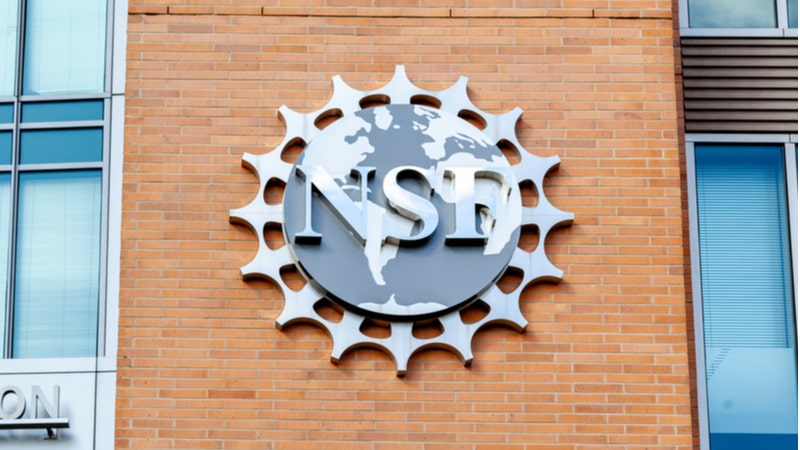
The National Science Foundation (NSF) officially launched the National Artificial Intelligence Research Resource (NAIRR) pilot today to serve as a shared national infrastructure to support the AI research community and power responsible AI use.
NSF partnered with 10 other Federal agencies and over 20 leading AI industry and nonprofit partners to launch the NAIRR pilot. The pilot will provide U.S.-based researchers and educators with access to advanced computing, datasets, models, software, training, and user support.
The launch meets a goal set by President Biden’s recent AI executive order (EO), which directed NSF to launch the NAIRR pilot within 90 days.
In a press briefing with reporters on Tuesday afternoon, NSF Director Sethuraman Panchanathan said the NAIRR “has the potential to change the trajectory of our country’s approach to AI,” as it will lead the way for a trustworthy AI ecosystem.
“The breadth of partners that have come together for this pilot underscores the urgency of developing a National AI Research Resource for the future of AI in America,” Panchanathan said. “By investing in AI research through the NAIRR pilot, the United States unleashes discovery and impact and bolsters its global competitiveness.”
In addition to NSF, the current government partners for the NAIRR include the Department of Energy (DoE), Department of Veterans Affairs (VA), NASA, National Institutes of Health (NIH), National Institute of Standards and Technology (NIST), National Oceanic and Atmospheric Administration (NOAA), Department of Agriculture (USDA), Defense Advanced Research Projects Agency (DARPA), U.S. Patent and Trade Office (USPTO), and the Department of Defense (DoD).
Some of the other non-governmental NAIRR partners include the Allen Institute for AI, Amazon Web Services (AWS), Anthropic, Cerebras, Databricks, EleutherAI, Google, Hugging Face, IBM, Intel, Meta, Microsoft, NVIDIA, Omidyar Network, OpenAI, OpenMined, Palantir, SambaNova Systems, Vocareum, and Weights and Biases.
Additionally, NSF said the newly formed AI Alliance – a group of leading AI organizations across industry, academia, and government – will work with the NAIRR pilot as a collaborating consortium.
The pilot will initially support trustworthy, responsible AI research. In the spring, NSF plans to expand the pilot to other areas including environment and infrastructure research, healthcare, human health, and AI education.
The pilot’s operations will be broken up into four focus areas:
- NAIRR Open, which will enable open AI research through access to diverse AI resources via the NAIRR Pilot Portal and coordinated allocations;
- NAIRR Secure, co-led by NIH and DoE, which will enable AI research requiring privacy and security-preserving resources;
- NAIRR Software, which will facilitate and investigate interoperable use of AI software, platforms, tools, and services for NAIRR pilot resources; and
- NAIRR Classroom, which will reach new communities through education, training, user support, and outreach.
Katie Antypas, director of NSF’s Office of Advanced Cyberinfrastructure, told reporters that researchers can discover initial resources available on the NAIRR pilot portal, such as open datasets and open models.
However, she said other resources such as computational system access will require researchers to submit an application for access to those resources.
“The researchers will request access to those systems that have limited resources available, they’ll be vetted based on their responsiveness to the open opportunity call, and then there’ll be a matching process where those requests are matched to the appropriate resources,” Antypas explained.
For example, if a researcher was studying extreme weather events, she said they could apply to then access NOAA and NASA datasets that are co-located with computing to investigate new modeling techniques.
Another example Antypas gave is an AI educator from a community college or minority-serving institution that could receive resources for their classroom, “so their students can do their homework assignments with integrated virtual notebooks that are backed by compute.”
Initially, through the January launch, Antypas said that NSF predicts the NAIRR pilot will support about 25 to 50 research projects. As NSF brings more resources online and integrates capabilities from its partners in the spring, the agency expects to support roughly 100 to 400 projects.
“The number of projects and teams we can support will really depend on the resources that become available and come online,” Antypas said.
“This field is moving incredibly fast and so there is not going to be one single entity that is building the NAIRR,” she added. “We’re going to need the best ideas from the community in order to really go through this community design process to design and inform the full NAIRR.”
To that end, NSF is issuing a request for information (RFI) today for the research and educator community to receive feedback on the NAIRR pilot and hear their priority use cases.
The agency is also welcoming additional private sector and nonprofit partners for the NAIRR pilot. Those interested are encouraged to reach out to NSF at nairr_pilot@nsf.gov.
“Partnerships are really at the core of the pilot,” said Tess deBlanc-Knowles, NSF’s special assistant to the director for AI. “It’s important to note that this is just the beginning. We hope to continue to bring partners on board after the launch, integrating in new resources as the pilot matures. And in doing so, extend the reach of the pilot so that we can serve more researchers and educators and more places and start to really make progress towards that bigger vision of the NAIRR of democratizing AI.”
